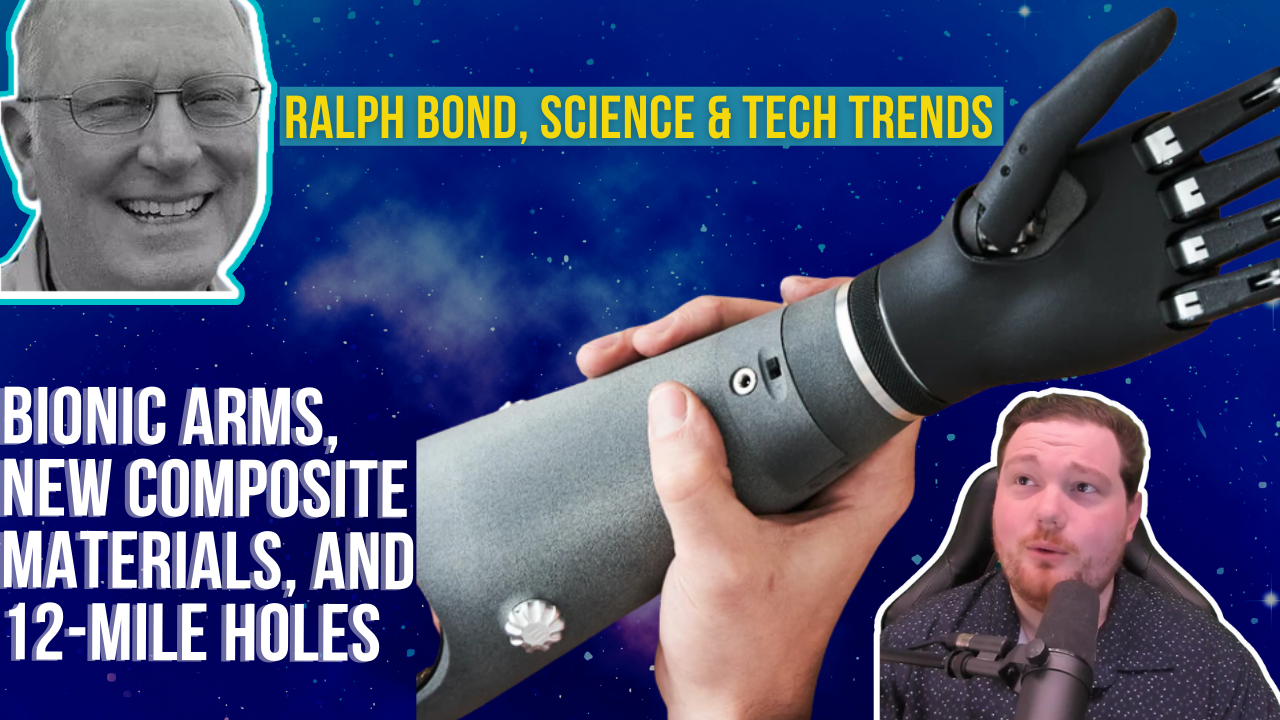Show notes for 4 March 2022
https://www.spreaker.com/user/computeramerica/bionic-arms-new-composite-materials-and-
Story 1: New tough as bone plant-derived composite from MIT
Source: MIT News Story by Jennifer Chu
Link: https://news.mit.edu/2022/plant-derived-composite-0210
The image on the left shows a tooth printed by the team resting on a background of wood cells.
Credit: Figure courtesy of the researchers, edited by MIT News. The image on the right shows cellulose nanocrystals
- Last Friday we talked about a new sustainable disinfectant made from sawdust that kills deadly microbes.
- Now there’s a new wood-based composite, developed by a team at Massachusetts Institute of Technology, which is as tough as bone.
- The strongest part of a tree lies not in its trunk or its roots, but in the walls of its microscopic cells.
- A single wood cell wall is constructed from fibers of cellulose — nature’s most abundant polymer, and the main structural component of all plants.
- Within each fiber are reinforcing cellulose nanocrystals, which are chains of organic polymers arranged in nearly perfect crystal patterns.
- At the nanoscale [meaning at the tiny size of billionths of a meter], these cellulose nanocrystals are stronger and stiffer than Kevlar.
- If the crystals could be worked into materials in significant amounts, cellulose nanocrystals could lead to more sustainable, naturally derived plastics.
- Recently scientists at MIT engineered a composite made mostly from cellulose nanocrystals mixed with a bit of synthetic polymer.
- The organic cellulose crystals make up about 60 to 90 percent of their experimental composite material.
- The researchers found their wood cellulose-based composite is stronger and tougher than some types of bone.
- In one experiment the team 3D printed a human tooth replacement using the new composite.
Story 2: Light, flexible bionic hand uses AI and muscle memory to refine its touch
Source: Mashable.com, Inputmag.com and Esper Bionics company website
Link: https://www.inputmag.com/tech/self-learning-bionic-hand-esper-ces-2022/amp
See video here: https://mashable.com/video/bionic-hand-esper-bionics-ai-self-learning?jwsource=cl
- Today’s cybernetic prosthetic limbs can be cumbersome, sometimes even presenting more challenges than they try to correct.
- Ukrainian technology company Esper Bionics was recently granted FDA approval for a new, smarter prosthetic called Esper Hand.
- Taking advantage of advanced artificial intelligence and machine learning, the Esper Hand is a prosthetic designed to learn – and thus, improve – over time as it’s worn.
- 16 sensors in both the stump socket and within the hand component pick up on an individual’s muscle movements.
- It has movable fingers, thumb, and wrist.
- The Esper Hand will be available in five sizes, offering a variety of natural shapes.
- The Esper Hand works with Esper’s Cloud Program to keep it continually fed with new and improving user data.
- A key advantage of this new device is that it can recognize different usage situations and adjust its grip accordingly — such as cutting food, opening packaging, and using zippers.
- The startup is currently negotiating with U.S. clinics for the price to be between $16,000-$18,000.
Story 3: Battery-powered trains are picking up speed
Source: arsTechnica.com Story by Khari Johnson
Link: https://arstechnica.com/cars/2022/02/battery-powered-trains-are-picking-up-speed/
- All-electric power is rapidly becoming commonplace in cars and trucks and is being tested in planes, helicopters, and container ships.
- Now, all electric, battery powered only technology is coming to locomotives.
- The goal is to replace today’s diesel electric hybrid locomotives with a zero emissions alternative.
- Diesel electric hybrid locomotives work this way: The ignition of diesel fuel pushes pistons connected to an electric generator. The resulting electricity powers motors connected to the wheels of the locomotive.
- So, with all-electric locomotives polluting diesel is cut out of the equation.
- Recently Union Pacific Railroad agreed to buy 20 battery-electric locomotives from Wabtec and Progress Rail.
- The battery-electric locomotives will offer up to 3,000 horsepower, and a run time of up to 24 hours.
- Initially they will be used to sort train cars in rail yards in California and Nebraska.
- According to experts at the Lawrence Berkeley National Laboratory and UCLA’s Institute of the Environment and Sustainability using all-electric locomotives could save railroads $94 billion in fuel costs over 20 years.
Story 4: 12-mile-deep holes could convert power plants from fossil fuel to geothermal
Source: Fast Company Story by Adele Peters
Link: https://tinyurl.com/j7wrz694
- Iceland was one of the first countries to move to 100% renewable electricity, in part because they can tap into geothermal energy from its unique volcano-filled geology.
- In many other places, that energy option isn’t available. But a new technology could make geothermal power accessible anywhere.
- Now there’s a new startup called Quaise Energy that plans to deploy “millimeter wave-based” drilling systems that can drill as far as 12 miles underground—that’s 3 to 5 times deeper than typical oil and gas drilling—reaching a layer of hot rock with temperatures of 700 degrees Fahrenheit, or more!
- And that heat can be used as a constant power source essentially anywhere on the planet.
- The millimeter wave energy on the tip of a drill uses a much higher-frequency version of what happens in a microwave in which you cook food. So high, in fact it can melt and vaporize rock.
- And here’s the link to MIT. The millimeter wave energy being used was developed by MIT’s Plasma Science and Fusion Center.

